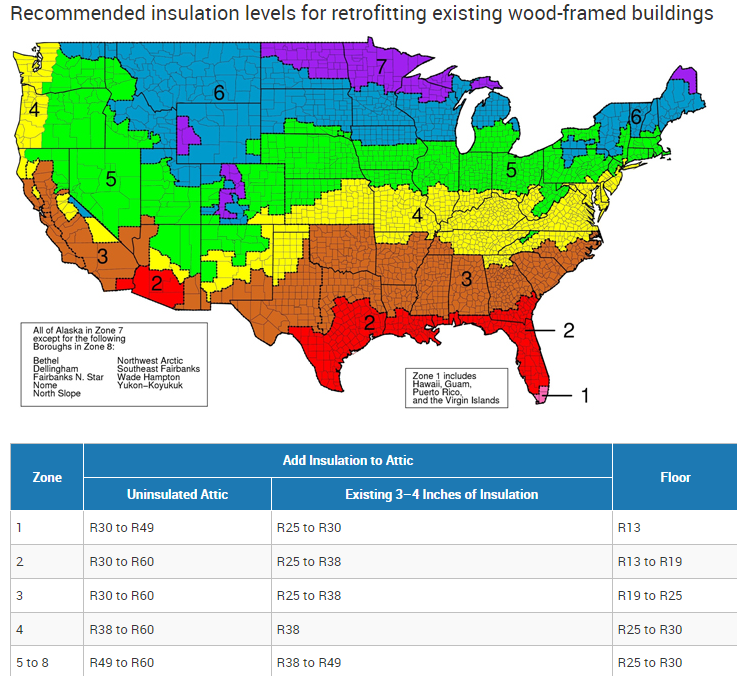ATTIC INSULATION IN MARYLAND
What is the recommended R-Value For an attic in maryland?
This is completely dependent on how much space you have within your attic, the way your attic is set up, and what is in your attic.
The short answer is, you should have R-49 at ALL flat sections. R-30-38 at ALL sloped sections or rooflines, and R-11-15 at ALL exterior wall sections or area’s touching an attic.
There are 2 typical ways to treat a standard attic:
Adding Blown Insulation
Attic Encapsulation
Why would you Encapsulate? R-30-38 would be the standard
If you use your attic for storage-the heat/cold can damage items
If you have ductwork in your attic- the system will struggle being outside of the “thermal envelope”
The attic is not vented-there is no way for moisture to escape the attic unless ventilation is added, which can be costly
Why would you add Blown Insulation?R-49 would be the standard
If you have an open attic with no storage and no future plans of using it in any way
It’s Easier/Most Cost Effective
The R-rating, or R-value, is a measure of the thermal resistance of insulation materials. It quantifies the insulation's ability to resist heat flow. The higher the R-value, the greater the resistance to heat transfer, and the better the insulation's effectiveness in reducing heat flow.
The R-value is influenced by factors such as the type of insulation material, its thickness, density, and any additional layers or components used. Different insulation materials have varying R-values per inch of thickness. For example, fiberglass batt insulation typically has an R-value of around 3.1 to 4.3 per inch, while cellulose insulation may have an R-value of about 3.2 to 3.8 per inch.
To determine the overall R-value for an insulated assembly or space, you need to consider the cumulative R-values of each insulation layer and any other components involved, such as sheathing, drywall, or air gaps. Adding layers or increasing the thickness of insulation can increase the overall R-value and improve the thermal performance of the building envelope.
It's important to note that the recommended R-value for insulation varies based on climate, local building codes, and specific application requirements. Different regions have different recommended minimum R-values for insulation in walls, roofs, floors, and other areas. Consulting local building codes or energy efficiency guidelines can provide specific recommendations for your area. Additionally, factors such as the building's design, orientation, and heating/cooling systems should be considered when determining the appropriate insulation R-value for a project.
Check out this chart below!
Is adding insulation to attic worth it?
Unless you have a perfectly insulated and air-sealed attic. Adding insulation would be 100% worth it and an improvement. A good way to gauge if it’s worthwhile would be the Energy Audit.
Can insulation R-value be too high?
While insulation with a high R-value is generally beneficial for improving energy efficiency and reducing heat transfer, it is possible for the R-value to be too high in certain situations. Here are a few considerations:
Cost-effectiveness: Insulation with very high R-values may come at a significantly higher cost. The incremental energy savings achieved by further increasing the R-value beyond a certain point may not justify the additional expense. It's important to strike a balance between insulation performance and cost-effectiveness.
Space limitations: In some cases, the available space for insulation installation may be limited. If the space is insufficient to accommodate a thick layer of high R-value insulation, it may not be practical or feasible to achieve extremely high levels of insulation in those areas.
Moisture management: Insulation with extremely high R-values can potentially trap moisture within the building envelope. Moisture issues such as condensation or trapped moisture can lead to mold growth, rot, or other structural problems. Proper ventilation and moisture control measures should be implemented alongside insulation to prevent moisture-related issues.
Climate considerations: The optimal R-value for insulation depends on the climate and local building codes. In colder climates, higher R-values are generally recommended to provide better insulation against cold temperatures. In warmer climates, it's important to consider the balance between insulation and heat transfer, ensuring adequate ventilation and moisture management.
It's crucial to consult local building codes, energy efficiency guidelines, and professionals with expertise in insulation to determine the appropriate R-value for your specific location and circumstances. They can help evaluate factors such as climate, budget, space limitations, and moisture management to ensure the insulation provides the desired benefits without creating potential issues.
What is the best insulation to put in an attic?
I would say check out our home page and refer to the top page for this, there are so many different situations within attics and to better understand what’s going on in yours in specific, it would be a really good idea to check it out and see what makes sense.



